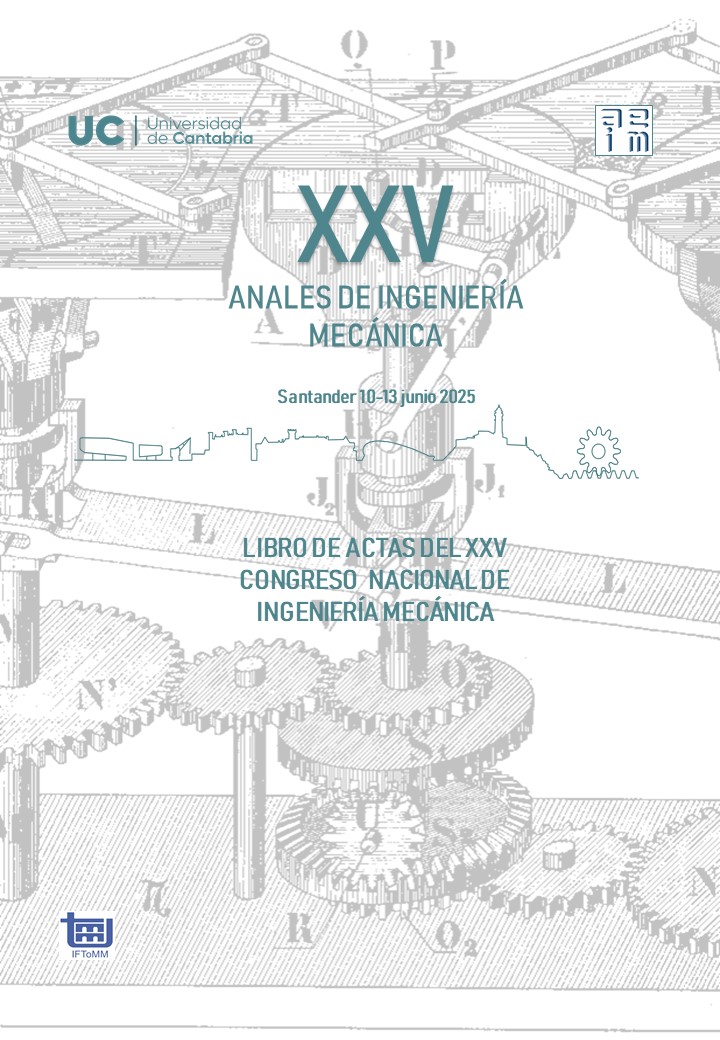Optimización de la distribución de carga interna en husillos a bolas
Contenido principal del artículo
Resumen
Los husillos a bolas son actuadores lineales de altas prestaciones empleados en diversas aplicaciones. Estas pueden ir desde aplicaciones de alta precisión, como puede ser el posicionado de ejes en máquina herramienta, hasta aplicaciones de alta fuerza de empuje siendo estos elementos sustitutos de cilindros hidráulicos. En estas últimas se acentúa el efecto de la no-uniformidad de carga interna.
La no-uniformidad de carga interna, implica entre otros aspectos que hay bolas sobrecargadas respecto a la carga media, que a su vez afectan a la vida útil del componente. Otro riesgo existente es la posibilidad de tener bolas con muy baja carga o completamente descargadas, lo que puede conducir a una rodadura deficiente o deslizamientos excesivos.
En la bibliografía, existen trabajos que analizan el problema, desde una perspectiva teórica y en menor medida experimentalmente. En ellos quedan patentes ciertos aspectos, como la clasificación de la no-uniformidad en dos categorías: global y local y la influencia de diferentes variables geométricas, destacando el factor de esbeltez del husillo como la más influyente. No obstante, con el fin de mitigar los efectos negativos de la no-uniformidad se han encontrado pocas soluciones más allá de sugerencias de aplicar errores puntuales, cambiar el tamaño de bolas o modificar la sección externa de la tuerca como indican diferentes patentes de algunos fabricantes.
En este trabajo se presentan diferentes soluciones de optimización de la distribución de la carga interna en husillos a bolas. Se destacan tres métodos de optimización: i) por paso variable corregido, ii) por desplazamiento de bolas y iii) por diseño de tuerca doble en serie. Con las propuestas de optimización presentadas se puede llegar a reducir la no-uniformidad global en un 57% en sus valores de carga pico.
Detalles del artículo

Esta obra está bajo una licencia internacional Creative Commons Atribución-NoComercial-CompartirIgual 4.0.
CC BY-NC-SA 4.0)
El lector puede compartir, copiar y redistribuir el material en cualquier medio o formato, siempre y cuando cumpla con las siguientes condiciones:
-
Atribución (BY): Debe dar crédito adecuado al autor original, proporcionando un enlace a la licencia y señalando si se han realizado cambios.
-
No Comercial (NC): No puede utilizar el material con fines comerciales. Esto significa que no puede venderlo ni obtener ganancias directas de su uso.
-
Compartir Igual (SA): Si adapta, transforma o construye sobre el material, debe distribuir sus contribuciones bajo la misma licencia que el original.
Recuerda que esta licencia no afecta los derechos legales del autor, como el derecho moral o las excepciones de uso justo.
Citas
C. Li, M. Xu, W. Song, and H. Zhang, “A Review of Static and Dynamic Analysis of Ball Screw Feed Drives, Recirculating Linear Guideway, and Ball Screw,” Int J Mach Tools Manuf, vol. 188, p. 104021, May 2023, doi: 10.1016/j.ijmachtools.2023.104021.
Y. Altintas, A. Verl, C. Brecher, L. Uriarte, and G. Pritschow, “Machine Tool Feed Drives,” CIRP Annals, vol. 60, no. 2, pp. 779–796, 2011, doi: 10.1016/j.cirp.2011.05.010.
F. Abevi, A. Daidie, M. Chaussumier, and M. Sartor, “Static Load Distribution and Axial Stiffness in a Planetary Roller Screw Mechanism,” Journal of Mechanical Design, vol. 138, no. 1, p. 12301, Jan. 2016, doi: 10.1115/1.4031859.
C.-C. Wei and W.-H. Kao, “Analyses of Contact Forces and Kinetic Motion on Heavy Load Ball-Screw,” MATEC Web of Conferences, vol. 185, p. 14, 2018, doi: 10.1051/matecconf/201818500014.
X. Mei, M. Tsutsumi, T. Tao, and N. Sun, “Study on the Load Distribution of Ball Screws with Errors,” Mech Mach Theory, vol. 38, no. 11, pp. 1257–1269, Nov. 2003, doi: 10.1016/S0094-114X(03)00070-3.
ISO-3408 Ball Screws. Part 5: Static and Dynamic Axial Load Ratings and Operational Life. 2006.
S. Xu, Y. F. Sun, and H. Shen, “Load Distribution of Ball Screw with Contact Angle Variation,” Applied Mechanics and Materials, vol. 397–400, pp. 435–440, Sep. 2013, doi: 10.4028/www.scientific.net/AMM.397-400.435.
J. Liu, H. Feng, and C. Zhou, “Static Load Distribution and Axial Static Contact Stiffness of a Preloaded Double-Nut Ball Screw Considering Geometric Errors,” Mech Mach Theory, vol. 167, p. 104460, Jan. 2022, doi: 10.1016/j.mechmachtheory.2021.104460.
N. Zhen and Q. An, “Analysis of Stress and Fatigue Life of Ball Screw with Considering the Dimension Errors of Balls,” Int J Mech Sci, vol. 137, pp. 68–76, Mar. 2018, doi: 10.1016/j.ijmecsci.2017.12.038.
J. Zhao, M. Lin, X. Song, and Q. Guo, “Investigation of Load Distribution and Deformations for Ball Screws with the Effects of Turning Torque and Geometric Errors,” Mech Mach Theory, vol. 141, pp. 95–116, Nov. 2019, doi: 10.1016/j.mechmachtheory.2019.07.006.
B. Lin, C. E. Okwudire, and J. S. Wou, “Low Order Static Load Distribution Model for Ball Screw Mechanisms Including Effects of Lateral Deformation and Geometric Errors,” Journal of Mechanical Design, vol. 140, no. 2, p. 22301, Feb. 2018, doi: 10.1115/1.4038071.
C. Liu, C. Zhao, X. Meng, and B. Wen, “Static Load Distribution Analysis of Ball Screws with Nut Position Variation,” Mech Mach Theory, vol. 151, p. 103893, Sep. 2020, doi: 10.1016/j.mechmachtheory.2020.103893.
R. Bertolaso, M. Cheikh, Y. Barranger, J.-C. Dupré, A. Germaneau, and P. Doumalin, “Experimental and Numerical Study of the Load Distribution in a Ball-Screw System,” Journal of Mechanical Science and Technology, vol. 28, no. 4, pp. 1411–1420, Apr. 2014, doi: 10.1007/s12206-014-0128-0.
M. Maiztegui, J. Larrañaga, A. Arana, A. Oyanguren, and I. Ulacia, “Non-Destructive Experimental Technique to Determine Ball Contact Load in Rolling Machine Elements,” Tribol Int, vol. 195, p. 109629, Jul. 2024, doi: 10.1016/j.triboint.2024.109629.
L. Sangalli, A. Oyanguren, J. Larrañaga, A. Arana, M. Izquierdo, and I. Ulacia, “Numerical characterization of local and global non-uniformities in the load distribution in ball screws,” International Journal of Advanced Manufacturing Technology, vol. 118, no. 5–6, pp. 1411–1425, 2022, doi: 10.1007/s00170-021-07978-4.
L. Sangalli, A. Oyanguren, M. Izquierdo, J. Larrañaga, and I. Ulacia, “Numerical study on the effectiveness of the optimization of the load distribution in ball screw actuators,” Mech Mach Theory, vol. 203, Nov. 2024, doi: 10.1016/j.mechmachtheory.2024.105781.

